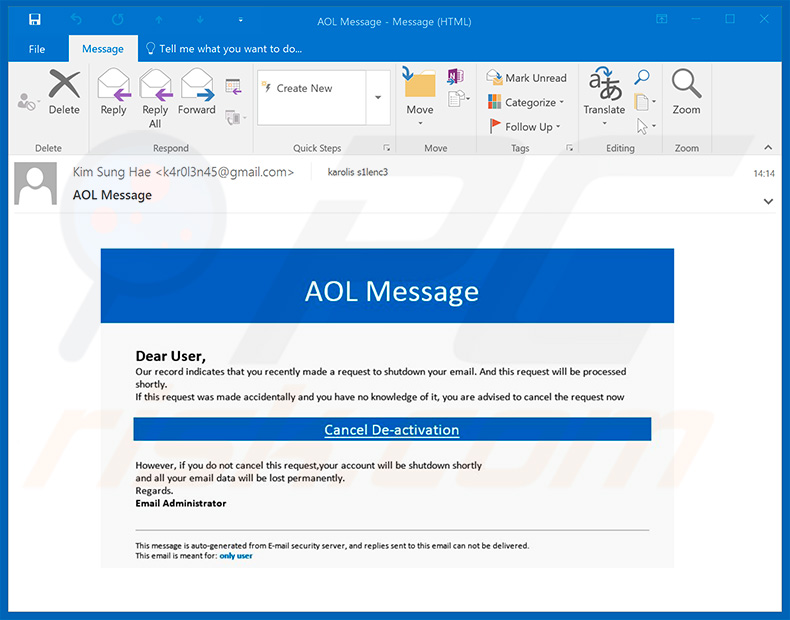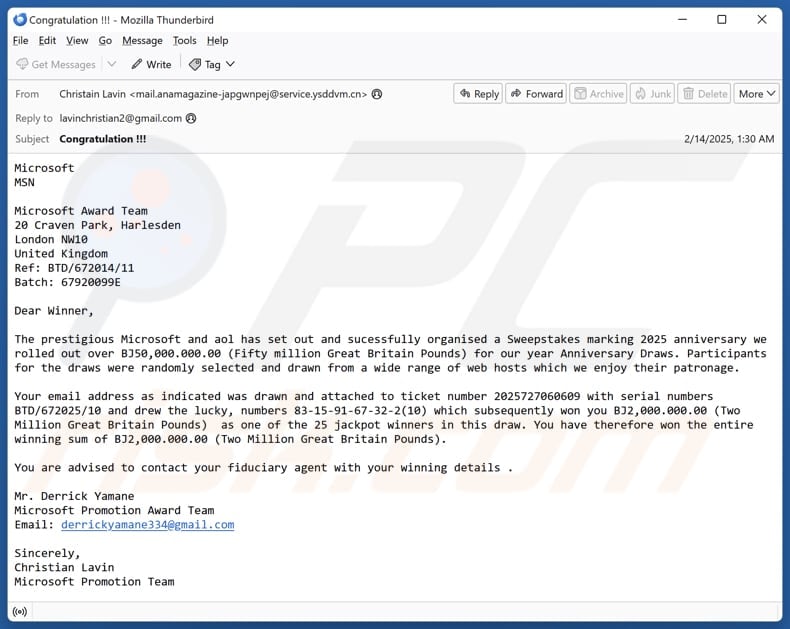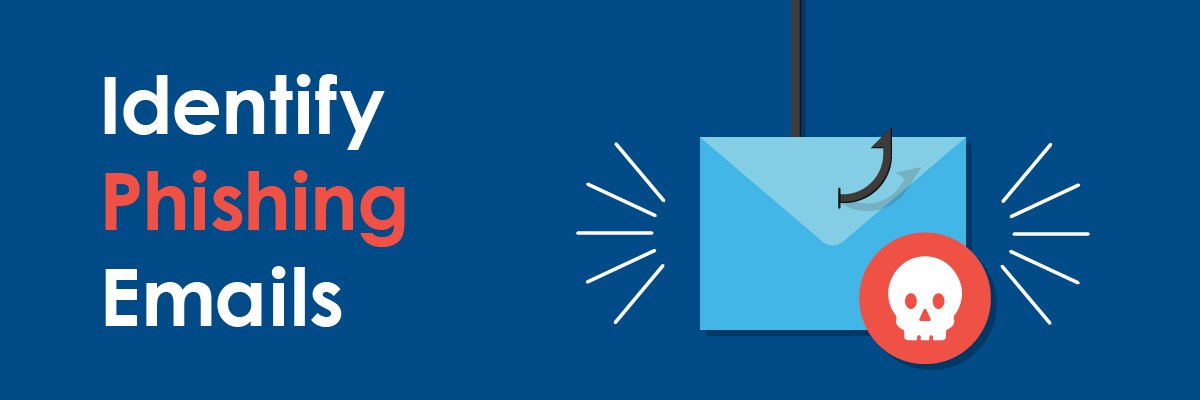Phishing emails pose a serious threat to your online security. They aim to steal your personal information.
Identifying these scams is crucial to staying safe. AOL users are often targeted by phishing emails. These emails can look very convincing. They may ask for your login details or personal information. Falling for these scams can lead to identity theft or financial loss. In this guide, you’ll learn how to spot AOL phishing emails. We’ll also provide practical tips to avoid getting scammed. Protecting your online security is essential. For added protection, consider using a VPN service like NordVPN. It enhances your privacy and security. Stay informed and stay safe online.
Introduction To Aol Phishing Emails
AOL users often become targets for phishing scams. These scams can trick you into giving away personal information. Understanding how these phishing emails work is crucial.
What Are Phishing Emails?
Phishing emails are fraudulent messages. They seem legitimate but aim to steal your sensitive data. Typical targets include usernames, passwords, and credit card numbers.
They often mimic trusted companies or contacts.
Include links to fake websites.
It may contain malicious attachments.
Why AOL Users Are Targeted
AOL has a large user base. This makes it attractive for scammers. Many AOL users are older, less tech-savvy individuals. This group is more likely to fall for phishing scams.
Reason | Details |
|---|---|
Large User Base | Millions of users worldwide. |
Older Demographic | Less familiar with modern online threats. |
Trust in AOL | Scammers exploit this trust. |
Being aware of these factors can help you stay vigilant. Recognize the signs of phishing emails and protect your personal information.
Key Characteristics Of Aol Phishing Emails
AOL phishing emails can be tricky to identify. Scammers use clever tactics to make these emails look legitimate. Understanding the key characteristics of these phishing attempts can help you avoid falling for their traps.
Suspicious Sender Addresses
The sender’s address is one of the first signs of a phishing email. Phishing emails often come from addresses that look similar to legitimate ones but differ slightly.
Legitimate | Phishing |
|---|---|
support@aol.com | support@ao1.com |
info@aol.com | info@aol.net |
Look closely at the email address. Any unusual characters or domains should raise a red flag.
Generic Greetings And Subject Lines
Phishing emails often use generic greetings. Instead of addressing you by name, they might start with “Dear User” or “Dear Customer”.
Additionally, the subject lines can also be vague or too generic. Examples include:
“Important Update”
“Account Alert”
“Action Required”
If the email does not address you personally, be cautious.
Urgent Or Threatening Language
Phishing emails frequently use urgent or threatening language to prompt immediate action. Examples of such language include:
“Your account will be suspended.”
“Immediate action required”
“Verify your account now.”
Scammers hope to scare you into clicking on their links or providing personal information. Always take a moment to think before reacting to urgent requests.
Links And Attachments
Phishing emails often contain malicious links or attachments. These can look legitimate but lead to fake websites that steal your information.
Hover over links before clicking. Check the URL to ensure it directs to a legitimate AOL website. Avoid downloading attachments from unknown or suspicious emails, as they can contain malware.
Knowing these key characteristics, you can better protect yourself from AOL phishing emails.
Common Tactics Used In AOL Phishing Scams
AOL phishing scams use various tactics to deceive users. Understanding these tactics helps protect your personal information. Below are some standard methods used by scammers:
Spoofed Email Addresses
Scammers often use spoofed email addresses that look like official AOL emails. They change the sender’s address to appear legitimate. Check the email address carefully. Look for slight variations or misspellings. If unsure, contact AOL support directly.
Fake Login Pages
Phishing emails may link to fake login pages. These pages look like AOL’s official site. They aim to steal your login credentials. Always verify the URL. Genuine AOL pages have ‘aol.com‘ in the address. If the URL seems off, do not enter your details.
Malware Attachments
Phishing emails might contain malware attachments. These attachments could be disguised as legitimate files. They often come with urgent messages prompting you to open them. Avoid opening attachments from unknown senders. Use antivirus software to scan suspicious files.
Social Engineering Techniques
Scammers use social engineering techniques to manipulate users. They may pose as trusted individuals or entities. Their goal is to gain your trust and access to your information. Be cautious of unsolicited requests for personal details. Verify the identity of the person contacting you before sharing any information.
How To Verify The Authenticity Of Aol Emails
Phishing emails can be deceptive, mimicking legitimate AOL communications to trick users. Verifying the authenticity of AOL emails is crucial to avoid scams and protect your personal information.
Checking The Sender’s Email Address
Constantly scrutinize the sender’s email address. Authentic AOL emails come from addresses ending in @aol.com or @aim.com. Be cautious of slight variations or misspellings that may indicate a phishing attempt.
Hovering Over Links
Before clicking on any links, could you hover your mouse over them? This reveals the actual URL. Authentic AOL links will usually contain aol.com. Avoid clicking on links with unfamiliar or suspicious URLs.
Examining Email Content
Phishing emails often contain poor grammar, spelling mistakes, or generic greetings. Authentic AOL emails will address you by name and maintain a professional tone. Be wary of urgent language prompting immediate action.
Contacting AOL Support Directly
If you are unsure about the authenticity of an email, contact AOL support directly. Use the official AOL website or their known contact numbers. Do not use the contact details provided within the suspicious email.
Steps To Take If You Suspect An Aol Phishing Email
Taking immediate action is crucial if you suspect that an email you received is a phishing attempt. Follow these steps to protect yourself from scams and safeguard your personal information.
Do Not Click On Any Links Or Attachments
The first step is to avoid clicking on any links or attachments in the suspicious email. These could contain malware or lead to fraudulent websites that steal your information.
Report The Email To Aol
Next, report the suspicious email to AOL. Forward the email to phishing@aol.com for review. Reporting these emails helps AOL track and block phishing attempts.
Delete The Suspicious Email
After reporting the email, delete it from your inbox. This step ensures you won’t accidentally interact with the harmful content later.
Monitor Your Accounts For Unusual Activity
Finally, keep an eye on your accounts for any unusual activity. Check your bank statements and online accounts for unauthorized transactions.
If you notice anything suspicious, change your passwords immediately and contact your bank or relevant service provider for further assistance.

Credit: www.pcrisk.com
Preventative Measures To Protect Yourself From Aol Phishing Scams
Protecting yourself from AOL phishing scams is essential. Scammers are getting more sophisticated. Hence, taking preventative steps to safeguard your personal information is crucial. Below are some practical measures to help you stay secure.
Enable Two-factor Authentication
Two-factor authentication (2FA) adds an extra layer of security to your AOL account. It requires a second form of identification besides your password. This could be a code sent to your phone or an authentication app. Enabling 2FA makes it much harder for scammers to access your account, even if they have your password.
To set up 2FA on AOL:
Go to your account settings.
Select “Account Security.”
Choose “Two-Factor Authentication.”
Follow the prompts to complete the setup.
Regularly Update Your Passwords
Changing your passwords regularly is a simple yet effective way to enhance your security. Use complex passwords that combine letters, numbers, and symbols. Avoid using the same password for multiple accounts. Regular updates reduce the chances of your password being compromised.
Consider using a password manager like NordPass to securely generate and store strong passwords. This ensures you don’t have to remember multiple complex passwords.
Educate Yourself And Others
Understanding the common signs of phishing emails can prevent you from falling victim. Phishing emails often contain urgent messages, suspicious links, or attachments. They may ask for personal information or direct you to a fake website.
Share this knowledge with friends and family to help them stay safe. The more people are aware, the harder it is for scammers to succeed.
Use Security Software
Installing reliable security software can provide an additional layer of protection. Tools like NordVPN offer malware protection, ad blocking, and tracker blocking. These features help identify and block phishing attempts before they reach your inbox.
Feature | Description |
|---|---|
Malware Protection | Scans for and blocks malware |
Ad Blocking | Blocks unwanted ads |
Tracker Blocking | Blocks online trackers |
These preventative measures can significantly reduce your risk of falling victim to AOL phishing scams. Stay vigilant and update your security tools to maintain a safe online environment.
Conclusion And Final Thoughts
Identifying AOL phishing emails is crucial for maintaining your online security. You can avoid falling victim to these scams by staying informed and vigilant. Let’s wrap up with key takeaways and additional resources to help you stay protected.
Recap Of Key Points
Verify the Sender: Check the email address and domain for authenticity.
Look for Red Flags: Be cautious of urgent requests, spelling errors, and unfamiliar links.
Use Security Tools: Employ reliable antivirus software and VPN services like NordVPN to protect your data.
Report Suspicious Emails: Forward phishing attempts to the appropriate authorities or email providers.
Encouragement To Stay Vigilant
Staying alert is your best defence against phishing scams. Always double-check emails and be sceptical of unsolicited messages. Use tools like NordVPN to enhance your online security and privacy.
Resources For Further Information
Resource | Description |
|---|---|
Provides advanced encryption and malware protection to secure your online activity. | |
Offers tips on how to recognize and avoid phishing scams. | |
Provides updates and information on how to protect your AOL account. |
Utilizing these resources and maintaining a proactive approach can significantly reduce the risk of falling prey to phishing scams.

Credit: www.pcrisk.com

Credit: myldi.com
Frequently Asked Questions
How To Tell If An AOL Email Is Legit?
Check the sender’s email address for accuracy. Look for typos and unusual requests. Verify links before clicking. Be cautious with attachments. Use AOL’s official website to confirm.
What Are 3 Signs That A Suspicious Email May Be A Phishing Email?
1. The email requests sensitive information urgently. 2. The sender’s email address looks suspicious or unfamiliar. 3. The email contains unexpected attachments or links.
Is It Better To Delete Or Report Phishing Emails?
Report phishing emails to your email provider for better security. After reporting, delete them immediately to avoid risks.
How Do I Stop AOL Phishing Emails?
To stop AOL phishing emails, mark them as spam. Update your AOL password regularly. Enable two-factor authentication. Use email filters to block suspicious addresses. Stay cautious, and don’t click on unknown links.
Conclusion
Stay vigilant while checking your emails. Identify AOL phishing attempts effectively. Look for suspicious signs. Protect your personal information. Always verify the email sender. Use tools like Nord VPN for added security. Secure your online activity and avoid scams. Stay informed and cautious. Your safety online matters.
